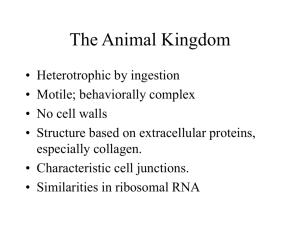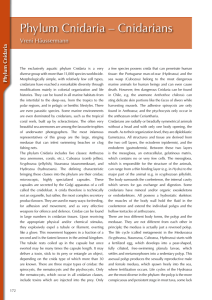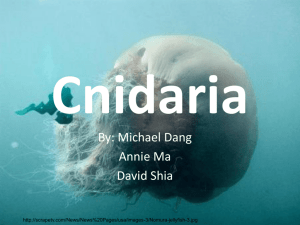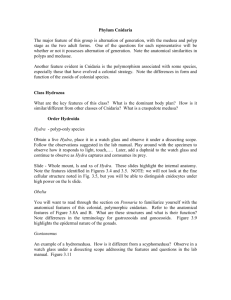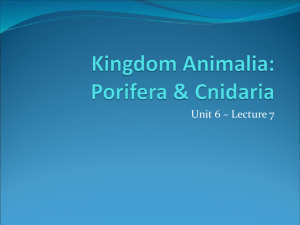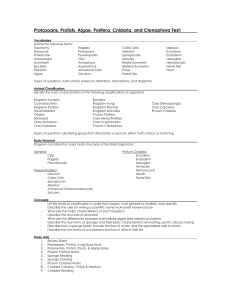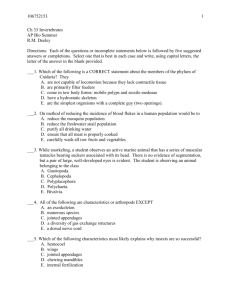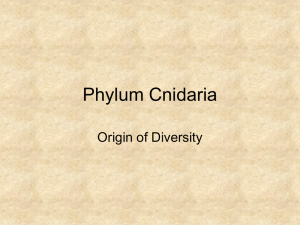File - MR. Hill's class
advertisement
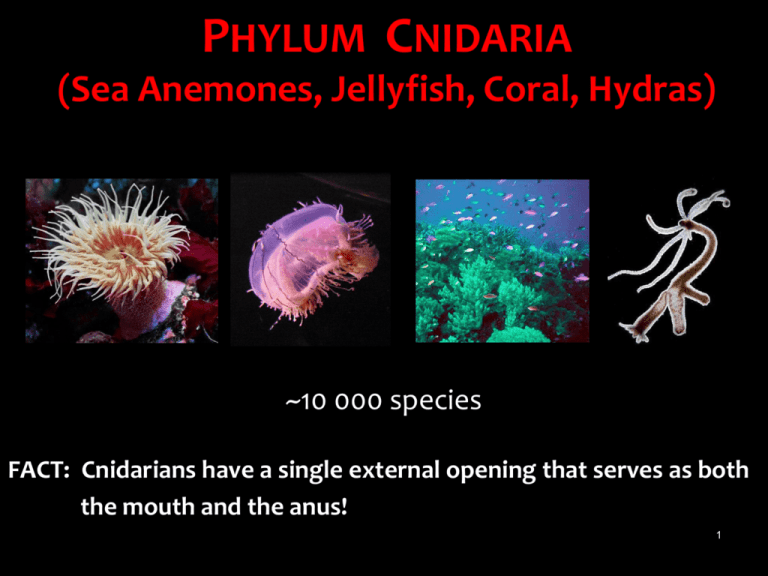
PHYLUM CNIDARIA (Sea Anemones, Jellyfish, Coral, Hydras) ~10 000 species FACT: Cnidarians have a single external opening that serves as both the mouth and the anus! 1 CNIDARIA Cnidae refers to the creatures’ “stinging cells” Are further up the “evolution ladder” meaning they are more complex than Porifera (sponges) Three Classes Class Hydrozoa Class Scyphozoa Class Anthozoa 2 CNIDARIA MULTICELLULAR cells are specialized and organized into tissues and sometimes even into simple organs all Cnidarian have specialized defense cells that sting = cnidocytes cnidocytes (the cell) contain a unique organelle = called nematocyst = “stinger” GERM LAYERS Only endoderm and ectoderm Endoderm – forms inner gastrodermis Ectoderm – forms outer epidermis 3 CNIDARIA MOVEMENT medusa form (bell-shaped) is motile (moving) polyp form (vase-shaped) is sessile (non-moving) some cnidarians exist in both forms throughout their life cycle (alteration of generations) medusa (motile) polyp (sessile) 4 CNIDARIA Two body forms Polyp Tubular shape Mouth faces upwards Sessile Medusa Mouth faces downwards Motile (drifters) 5 CNIDARIA REPRODUCTION Asexual – budding Sexual – monoecious, produce both sperm and eggs Sexual – male (produce sperm) - female (produce eggs) 6 CNIDARIA no body cavity because no true mesoderm radial symmetry non-segmented have tissues gastrodermis (gas exchange and digestion) epidermis (protection) middle layer = mesoglea (jelly-like) have a “nerve net” 7 CNIDARIA DETAILED STRUCTURE (Example of Hydra) 8 CNIDARIA • BODY SYSTEMS REPRODUCTIVE SYSTEM – a rudimentary system in some organisms Asexual Reproduction budding (no system) Sexual Reproduction Monoecious = individuals produce both sperm (testis) and eggs (ovary) Dioecious = male produce sperm (testis) and females produce eggs (ovary) 9 CNIDARIA • BODY SYSTEMS REPRODUCTIVE SYSTEM and LIFE CYCLES Alternation of generations Aurelia (jelly fish) http://trc.ucdavis.edu/biosci10v/bis10v/week9/moonjellemba.mov Obelia (hydra) 10 CNIDARIA • BODY SYSTEMS DIGESTIVE SYSTEM – not a true system food enters gastrovascular cavity via mouth extracellular digestion (enzymes secreted into cavity) cells lining the cavity absorb digested nutrient and smaller food particles 11 CNIDARIA • BODY SYSTEMS CIRCULATORY SYSTEM – not a true system nutrients and gasses diffuse directly across the thin cell layers RESPIRATORY SYSTEM – not a true system gas exchange directly between cells and water by diffusion (O2 diffuses into and CO2 out of cells) Both across epidermis and gastrovascular tissues 12 CNIDARIA • BODY SYSTEMS EXCRETORY SYSTEM – not a true system waste diffuses from cells into gastrovascular cavity waste is then released through the mouth MUSCULAR SYSTEM – NONE no muscle cells but some cells can contract and relax (e.g. in the tentacles) SKELETAL SYSTEM – NONE 13 CNIDARIA • BODY SYSTEMS Nervous System – a basic system a net of nerve cells react to presence of food and danger for feeding and protection Hydra Feeding 14 CNIDARIA • GENERAL INFORMATION HABITAT mostly marine waters (marine = salt water) some freshwater species SIZE as small as 0.5 cm tall bell of up to 2.4 m diameter and tentacle ranging upwards of 50 meters 15 CNIDARIA - Class Hydrozoa colonial organisms hydras, Portuguese Man-of-War medusa and polyp forms 16 CNIDARIA - Class Scyphozoa “Cup Animals” jelly fish predominantly in the medusa form 17 CNIDARIA - Class Anthozoa “Flowering Animals” sea anemones coral predominantly in the polyp form sea anemone and clown fish coral 18 http://www.youtube.com/watch?v=pYUZxS1b ZR4 = Steve Irwin and Box Jelly 19
